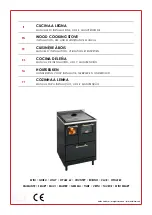
17
Purevision LPV Freestanding
Issue 01 02/21
7.7
Important Information for Wood Burning
With a full load of wood and burning near nominal output the stove will need to be refuelled
approximately every 1-1.5 hours. One or two large logs will burn longer than a number of smaller
ones. Wood can usually be stacked higher in the stove than solid mineral fuel but care must be taken
that logs do not touch the baffle or the glass panels.
Do not
stack logs above the level of the tertiary
air inlet profiling in the rear ceramic firebox liners at the back of the stove.
Always make sure that flames are visible above the wood after re-fuelling for cleanest burning.
Burning without flames above the fuel will create unnecessary smoke
.
After re-fuelling open the
single air control fully OUT for 3 minutes or until the logs are fully blackened to achieve full flames
above the fuel.
Wood burns best on a bed of ash and it is therefore only necessary to remove surplus ash from the
stove occasionally to maintain a practical burning level and the rear air intake holes clear.
Burn only dry, well-seasoned wood, which should have been cut, split and stacked - under cover
from rain - for at least 12-24 months with free air movement around the sides of the stack to enable
it to dry out. Burning wet or unseasoned wood will create tar deposits in the stove and chimney and
will not produce a satisfactory heat output.
Wood that
is not properly dry (‘dry’ is considered to be
less than 20% internal moisture content) uses up energy from the burn process to evaporate the
water inside the wood thus creating very poor conditions for combustion
. The main cause of
burning problems with wood stoves is due to excessively damp wood. Wood can appear perfectly
dry on the outside but still contain 40-50% water on the inside. A moisture meter can be purchased
from stove and equipment suppliers if you wish to check your wood source is correct. Split a log and
check the inside as well as the outside.
7.7.1
Refuelling on to a low fire bed
If there is insufficient burning material in the firebed to light a new fuel charge, excessive smoke
emission can occur. Refuelling must be carried out onto a sufficient quantity of glowing embers and
ash so that the new fuel charge will ignite in a reasonable period. If there are too few embers in the
fire bed, add suitable kindling to prevent excessive smoke.
7.7.2
Fuel overloading
The maximum amount of fuel specified in this manual should not be exceeded, overloading can
cause excess smoke. Never load fuel above the bottom edge of the tertiary air profiling in the back
ceramic firebox liner or allow them to touch the glass. All models max log diameter = approx.
150mm. Max length = 320mm for 5kW, 550mm for 8kW models. One log is acceptable ONLY if
loading onto a hot well established fire bed.
7.7.3
Operation with door left open
Operation with the door open can cause excess smoke and spillage into the room. The appliance
must not be operated with the appliance door left open.
















































